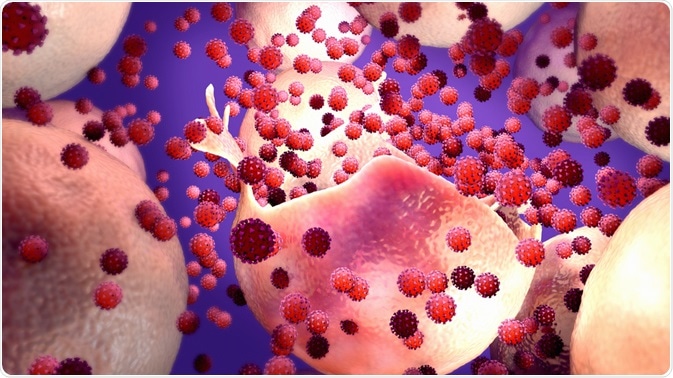Viruses cannot replicate on their own, but rather depend on their host cell’s protein synthesis pathways to reproduce. This typically occurs by the virus inserting its genetic material in host cells, co-opting the proteins to create viral replicates, until the cell bursts from the high volume of new viral particles.
 Image Credit: Design_Cells/Shutterstock.com
Image Credit: Design_Cells/Shutterstock.com
Main steps of viral replication
The replication cycle can be highly diverse between different species and categories of viruses. Despite this, there are generally six broad steps required for viral replication to occur successfully. These include attachment, penetration, uncoating, replication, assembly, and virion release.
The first stage, attachment, involves viral proteins binding to the host cell surface. There, they interact with receptors specific to them and their host cells. The specificity of viral attachment is a key decider of the range of hosts a virus can affect. This is also known as the tropism of a virus.
Once attached to the surface, viruses can gain entry to the cell via the changes that occur after binding. Binding a specific receptor can lead to conformational changes in the proteins on the viral capsid that lead to the viral and cellular membranes fusing. While this is one of the most common methods of penetration, some DNA viruses can enter host cells through receptor-mediated endocytosis.
Once inside the cell, the first step is uncoating. This involves the viral capsid degrading, either by the action of viral or host enzymes. This releases the genomic information (mostly in RNA form, but can be in DNA form). This enables the start of replication through transcription or translation for RNA or DNA viral genomic information, respectively. The result of the replication step is the synthesis of the viral genome and proteins.
The next step is assembly, in which the products of the replication step can be post-transcriptionally modified. The viral proteins and viral genome are then packed into new virions which can be released from the host cell. Assembly is also sometimes referred to as maturation.
The release of virions from the host cell can occur via two main methods. The lysis method results in the death of the host cell and the viruses that do this are usually referred to as cytolytic viruses. An example of this is smallpox.
Viruses with envelopes are more commonly released by budding, allowing the virus to gain a viral phospholipid envelope. These viruses do not usually kill the host cell and are known as cytopathic viruses. Influence A virus is an example of a cytopathic virus.
Viral replication and disease pathogenicity
Viral replication is critical for a virus’s ability to infect its hosts and spread. Because of this, it is a critical aspect of viral pathogenicity to understand. While some viral proteins typically stay in the host cell membrane, these can also occasionally be processed and presented on the surface of MHC class-I molecules. This can enable them to be recognized by T-cells, which play a critical role in immune responses.
HIV has an interesting replication cycle because it differs slightly from standard stages. Studies indicate that most of the viral particles found circulating the body come from continuous cycles of infection, replication, and turnover, as opposed to cells that chronically produce the virus or from cells that become latently infected and activated. This indicates that the viral replication of HIV is more local than that of many other viruses, with specific cell populations responsible for most viral replication.
Certain viruses have adaptations to allow for more efficient viral replication. For example, Ebola viruses have variable 3’ ends with additional nucleotides, which appear to provide additional stability for the initiation complex during replication. It is also theorized these extra nucleotides aid in immune evasion.
COVID-19 and inhibiting viral replication
COVID-19 has become a recent focus of viral replication studies. So far, over 300 human proteins have been found to interact with severe acute respiratory syndrome coronavirus 2 (SARS-CoV-2) during infection. It is believed that by blocking certain interactions between human and viral proteins, the viral replication can be stopped, thereby stopping transmission.
Similar therapeutic methods have been suggested for other diseases, such as HIV. When similar studies on interactions between human and viral proteins were done for HIV, they took a few years. Despite this, the interaction mapping for COVID-19 is progressing much quicker and many existing drugs that may be useful in stopping or slowing COVID-19 have been identified. However, many of these drugs have now been found to be ineffective.
There is some opposition to this method. Drugs targeting human protein function, which would then stop viral replication, might also produce side effects that are highly deleterious to already vulnerable patients. Some short-term drugs are seen as more applicable for COVID-19, but the wisdom and efficacy of this are still disputed.

Image Credit: Corona Borealis Studio/Shutterstock.com
References
- Goulding, J., 2020. Virus Replication. [online] Immunology.org. Available at: <https://www.immunology.org/es/public-information/inmunolog%C3%ADa-bitesized/pathogens-disease/replicacion-viral>.
- Wang, W., Wu, C., Amarasinghe, G., and Leung, D., 2019. Ebola Virus Replication Stands Out. Trends in Microbiology, 27(7), pp. 565-566.
- Marks, R., 2020. Unveiling How Coronavirus Hijacks Our Cells to Help Rush New Drugs to Patients. [online] UCSF.edu. Available at: <https://www.ucsf.edu/news/2020/03/416986/unveiling-how-coronavirus-hijacks-our-cells-help-rush-new-drugs-patients>.
- Wei, X., Ghosh, S., Taylor, M., Johnson, V., Emini, E., Deutsch, P., Lifson, J., Bonhoeffer, S., Nowak, M., Hahn, B., Saag, M. and Shaw, G., 1995. Viral dynamics in human immunodeficiency virus type 1 infection. Nature, 373(6510), pp. 117-122.
Further Reading